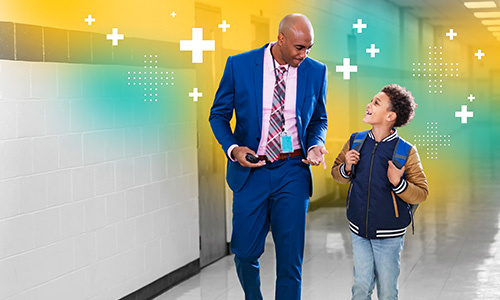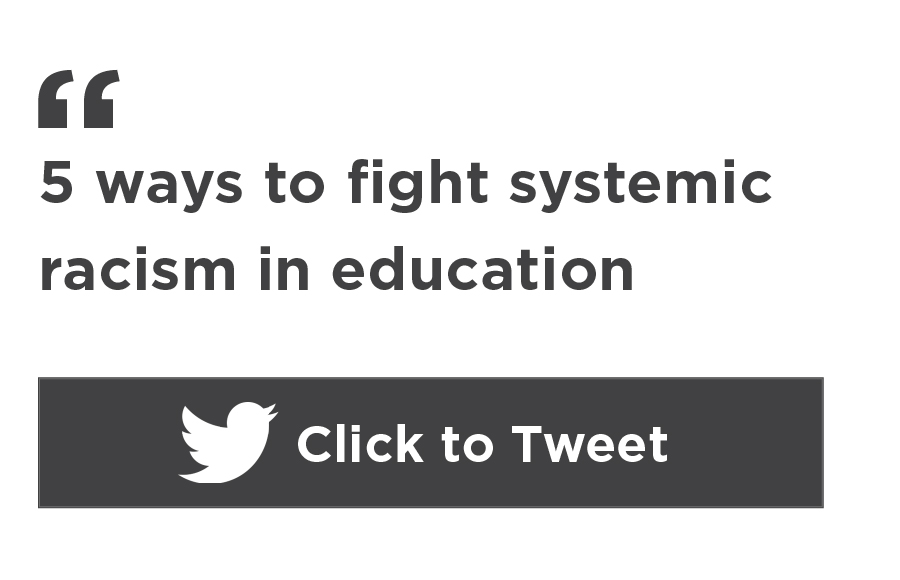It’s been a depressing summer. Coronavirus infection rates continue to rise in most of the country, and everything about the 2020–21 school year is overwhelmingly uncertain. The hope most of us had for a back-to-normal back to school is gone. As we face this reality, systemic racism continues to harm us and our children.
Coronavirus is already having a disproportionate effect on black people—from unemployment to infection and mortality rates—and we cannot let it deepen the divide in our schools, too. I sat down with Chris Canty, a black father of two young children in Madison, Wisconsin, to get his take on what families and educators can do to seize the moment. Because our kids can’t wait.
Can you tell me a bit about Madison? I’ve never been.
Madison is a really fun college town and it’s known for being a little more liberal than most of the other cities in Wisconsin. Despite Madison’s liberal reputation, there is still a lot of work to be done in the name of racial equality for our black and brown residents. I have always had positive experiences and I feel comfortable raising our two kids here. However, Madison sorely needs more diversity and less racial segregation throughout the city.
You were born and raised in Madison, right? What was that like for you?
I grew up on the far west side, which is known for being a little more affluent. My parents both had great jobs growing up, and I would consider us squarely in the above average, middle class camp. Our neighborhood didn’t have a lot of faces that looked like mine, but my parents’ network of black friends always created a place for fellowship within our home.
Do you feel like you were very aware that you were one of only a handful of black boys in your neighborhood and school growing up?
I don’t think I felt it as much growing up. I think I was more aware in college. Sitting in a lecture hall with 500 kids and seeing only five black people can be a little jarring. In college, as I started meeting more people, I gained a better understanding of diversity, what it means and why it should be valued. Ultimately, I definitely began to crave it more.
I think it’s important for everyone to think about their inherent bias as it relates to race because we all have bias. If you’re a teacher, it’s critical that you think about how your bias could impact […] the outcomes of your students.
Would I have liked to have had more diversity growing up? Absolutely. I wish all kids could have more diversity in their schools and neighborhoods. I truly believe that it helps everybody when you have true diversity.
What do you mean by “true diversity”?
People seem to think of diversity as simply black and white. I don’t always think of it that way. There’s more to diversity than that. To accomplish true diversity, we must incorporate the diversity of thought, diversity of color, and diversity of sexual orientation. There are so many different events and moments that can make a difference in a kid’s life.
Tell me a bit about the volunteer work you do to help kids.
I’m a board member of the 100 Black Men of Madison, a local organization with a national presence. I’ve been part of this group for 15 years because I believe in one of our core mottos, “What they see is what they will be.” It’s important for kids of color to see people who look like them but also people who look like them and have unique and interesting life experiences. I didn’t grow up in poverty, and I never pretend to know what that’s like or how to dig deep to lift myself or my family up out of a tough circumstance. But what I do know is that it’s good for young black boys to see me, hear my story, see the success that I have had in my life and understand that they can create their own unique pathway to a successful future.
In addition to being part of 100 Black Men, I sit on several community organization boards and panels to make sure that those who don’t have a strong voice will ultimately be heard. Whether it’s at a meeting with the United Way, the Madison school superintendent, or even state and federal politicians, I want to make sure that I can provide a voice for those who often go unheard.
I didn’t grow up in poverty, and I never pretend to know what that’s like […]. But what I do know is that it’s good for young black boys to see me, hear my story, see the success that I have had in my life and understand that they can create their own unique pathway to a successful future.
Many people in Madison have good intentions for this community and people of color, but black people know what’s best for black people. It’s our job to make sure that ideas on paper net positive outcomes and aren’t just pie-in-the-sky strategic goals.
For example, I attended a community summit around Madison Metropolitan School District’s strategic planning. During the meeting, there was a lot of talk of funding more charter schools. But I spoke up and said, “Have you actually been in a school recently? These kids need breakfast. They need a mattress. They need eight hours of quiet sleep. When you have a kid who’s getting 10 hours of sleep, four meals a day, snacks whenever they want, homework help, they’re comfortable. They’re safe. But then you have a kid who’s got parents working odd hours, doors getting slammed at one in the morning… That kid is at a structural disadvantage. A charter school won’t fix that.”
Sometimes I think the answers to a lot of our problems are really, really simple. But they take work.
Representation is critical. The right kind of representation. I feel like there’s a lot of misunderstanding around the power of representation in law enforcement, especially among school resource officers.
Madison just removed police from its four major high schools, and I support this decision 100%. People have asked me why, and it’s simple: Because, just like in real life, black kids are unfairly criminalized for doing basic stuff. If they get into a schoolyard fight, which should be maybe an in-school suspension, the next thing you know they’re being charged with a misdemeanor.
Some have argued that we shouldn’t take the police out of schools because that could mean fewer positive black faces there. My response? If you want a positive black face in your school, hire more black teachers, more black guidance counselors, more black principals, or have a black police officer come and speak instead. If the only way to see a working-class black face is through public safety personnel, we have a serious problem.
Have you been talking about racism with your five-year-old son this summer?
A little bit. We had the TV on the other day, and my son saw some footage of protestors. He asked me what they were mad about, and I talked to him about the killing of George Floyd. I explained that the situation was unjust and tried to simplify everything as much as I could.
If you want a positive black face in your school, hire more black teachers, more black guidance counselors, more black principals […].
You want to educate kids of color on racism, but you also want to shield them from growing up too fast. At this age, he just wants to run around and have a good time, you know? I think that’s true for most five-year-olds, regardless of color.
Your son will be going into a majority-white kindergarten classroom this fall, and his teacher will be white. What does she need to know about having very few black children in her classroom, especially now?
I think it’s important for everyone to think about their inherent bias as it relates to race because we all have bias. If you’re a teacher, it’s critical that you think about how your bias could impact—positively or negatively—the outcomes of your students. Bias can affect what and how a child learns.
Do you have any advice for district and school administrators?
Make more room for leaders of color and more black and brown teachers. Growing up I had a black female principal and it made a huge difference in my elementary school experience. It makes a difference when black students, teachers, and parents have someone at the top that better understands their lived experience.
Do you have any advice for families?
Engage with your kid’s teachers and principals. The new principal at the school my son will go to for first grade is a black woman. As soon as I found out, I friended her on Facebook and connected on LinkedIn. We were immediately engaged in a conversation about how she could network with parents during these challenging pandemic summer months. I suggested she get in front of people right away, introduce herself and hear their concerns.
Don’t be afraid to ask questions that might make things a little uncomfortable. If you don’t, you’re just going to get generic answers.
We also need to create advocacy groups with other families and try to get support for policies and strategies we believe in. For example, if there’s a decision we’re concerned about, it’s much easier to make outreach and get someone at a board meeting if there’s already an advocacy group in place.
Lastly, don’t rush it. Start off a bit easy if you can. If you’re just getting to know an educator, focus on building a relationship first. Share details on your background, then ask about theirs. Talk about your family values at home and ask about their values in the classroom. Then work toward the really big questions: What do you feel your biases are? What is your experience with African American students? Don’t be afraid to ask questions that might make things a little uncomfortable. If you don’t, you’re just going to get generic answers.
Do you ever have concerns about people treating African Americans like a monolith? I’ve experienced that as a Hispanic person. As a country, we seem to have decided a Hispanic person is always brown, is probably poor, is probably going to speak English as a second language. But none of those things are true of me.
That’s a really good point. You might see a black kid and think, “Oh, he’s probably in a lower social-economic group.” But you can’t know that for sure. Yes, poverty rates are higher among people of color. But that doesn’t mean every person of color has the exact same lived experience.
There’s research that shows white teachers tend to expect less of black children, so some set the bar lower to begin with. That’s particularly troubling with a kid like yours who is so smart, so ready for anything. If his teachers lower the bar for him, what damage are they going to do?
Exactly. I think of LeBron James’ school in Ohio and all these smiling black faces. You know what they’re doing? Giving kids a space to create, to learn.
Let’s sum things up for our readers. It sounds like you have five basic recommendations for families and educators.
Yes. Here they are.
- Families should put themselves in positions where they can speak up for underrepresented kids.
- Families should build relationships with educators and each other.
- Educators need to support more leaders of color.
- Educators should check their bias.
- Educators should be careful not to assume that every child—especially every black child—has the same lived experience.









